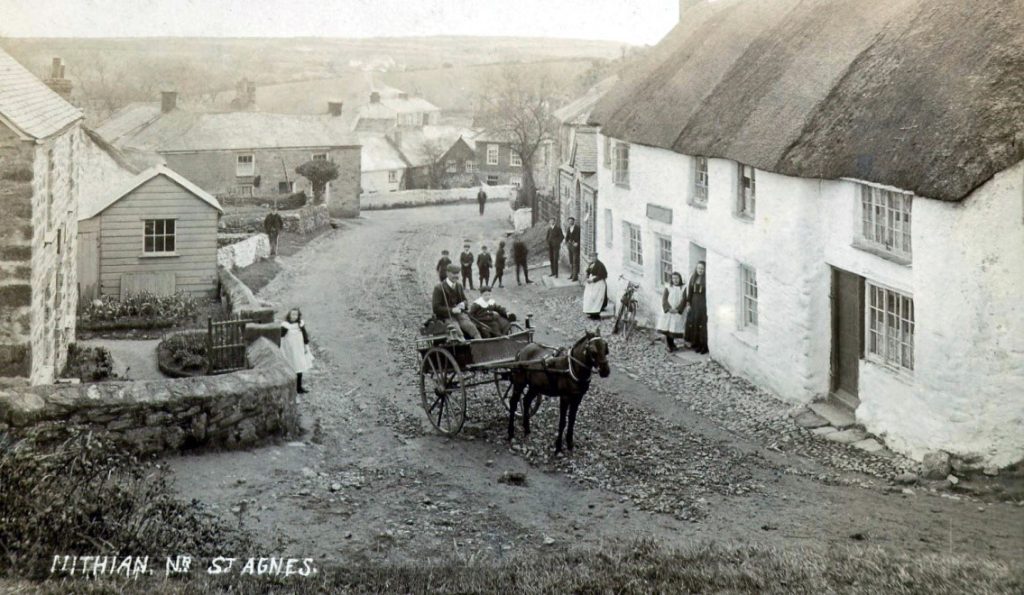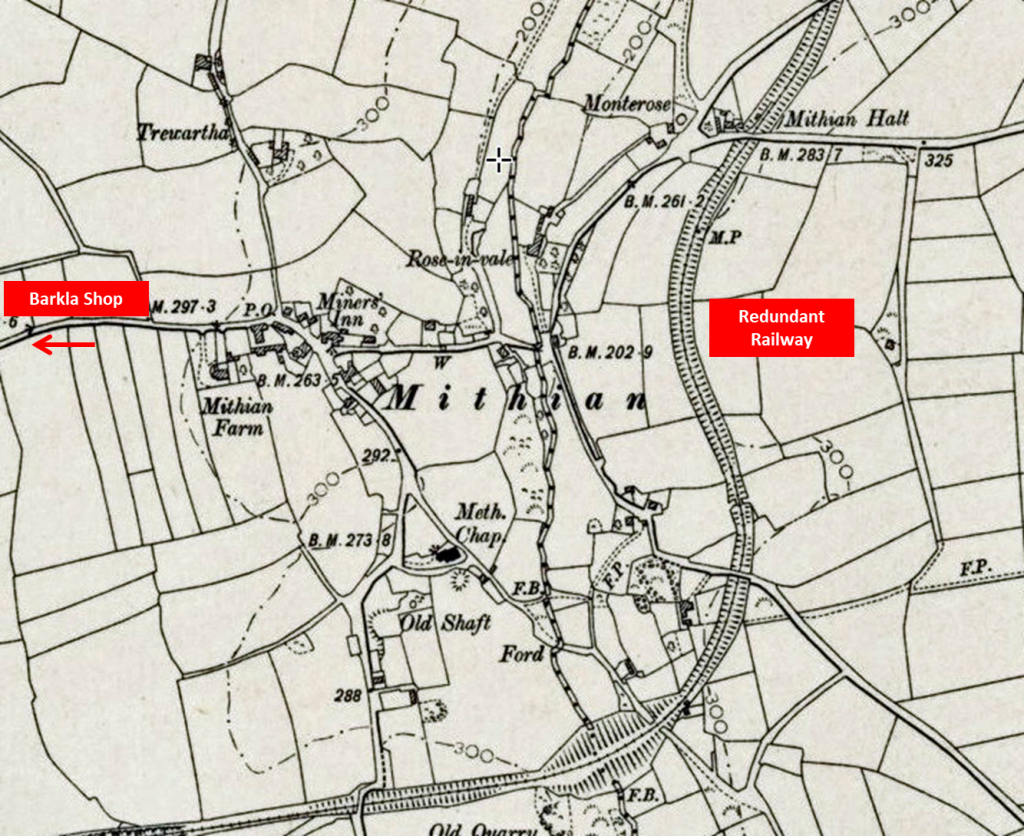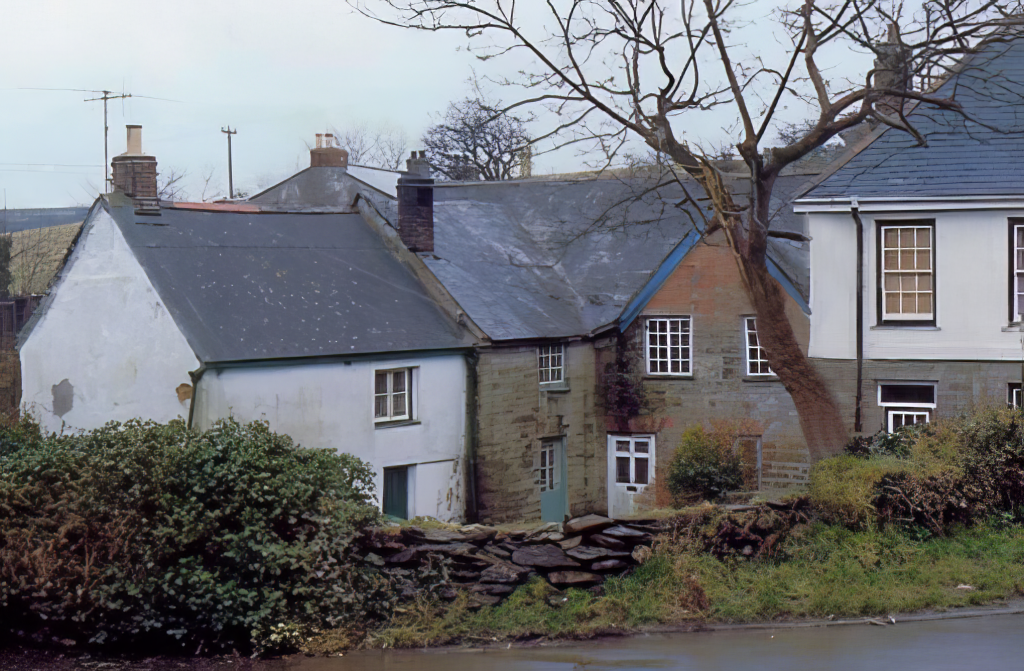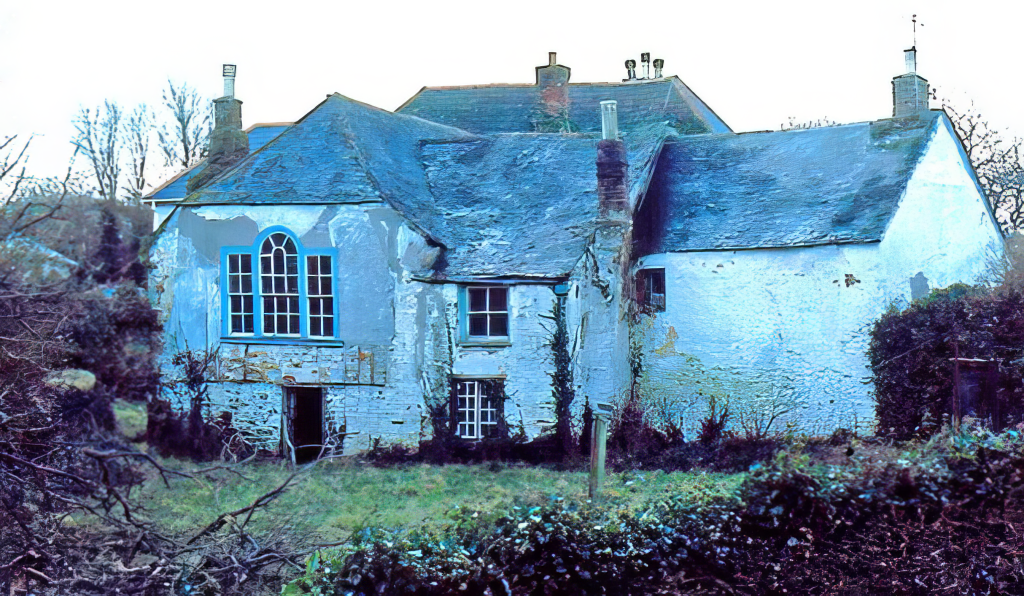
Tony Mansell continues this series with an article about this charming Cornish village where his wife was born and where his family lived for many years.
Mention the little village of Mithian (1) and most folk will think of the Rose in Vale Country House Hotel or its gem of a pub, the Miners Arms. It is certainly an idyllic location, well worth a visit and when it comes to mystery and intrigue it certainly punches well above its weight. It has it all: its ghosts, its lost chapels, its secret tunnel and much, much more.
Let’s start by considering its name the spelling of which has varied across the years and is suggested to be Cornish rather than English. However, no Cornish, Welsh or Breton word is known that could explain it.
The village is clearly an ancient settlement and the Cornwall Monuments Records state that its first recorded mention was in 1201. If it existed in 1086, when William the Conqueror’s Domesday Book was compiled, it would have been as a part of Tywarnhayle Manor. It seems that a Norman/French nobleman occupied this sub-manor and it appears likely that this unknown person was granted it for services rendered to the King or to his half-brother, the Count of Mortain.Some 450 years after William I ceased to have any influence over earthly matters the ownership of the manor was lost due to one of Cornwall’s famous rebellions. In 1549 the Cornish took up arms in protest at the religious revolution that saw Protestantism replace Catholicism; this bloody conflict was dubbed the Prayer Book Rebellion and it shook the English nation to its roots. The army of Edward VI eventually defeated the Cornish/Devonshire rebels and wielded brutal retribution against them. One of those who led the uprising was John Wynslade, Lord of this sub-manor. He was hanged, drawn and quartered and his lands sequestered and taken over by the Mohun family.



You would be excused for assuming that the ghost of Mithian was none other than John Wynslade wandering his manor in an attempt to reclaim it. Of course, that may well be true but the suggestion has sprung from my imagination so we will not pursue it. The ghosts in question, and yes they are in the plural, seem to be restricted to two properties: Rose Merryn, situated on the edge of the village, and the Miner’s Arms, the only remaining public house in the village. The lady at Rose Merryn describes her visitor as a young male with blonde curly hair, fine features and blue eyes. He is dressed in working clothes, black trousers and a light coloured or white shirt, all of which are old fashioned in appearance. He is opaque and when he sits on the bed he depresses the mattress. He is rather timid but has touched her shoulder and once placed his hand over her mouth when she tried to ask him a question. She is totally relaxed in his presence and accepts it without fear. Her predecessor at the house was also aware of him and would often say, “My little friend came to visit me last night”. Of course, no self-respecting pub of a certain vintage would be without its resident ghost and the Miners Arms is no exception. One paying guest apparently received a blow on his back as he descended the stairs and children living there have claimed to have seen a ghostly figure. A former landlord talked of glasses falling off shelves onto the hard floor yet remaining unbroken. On one occasion the sachets of sauces were neatly arranged on the dining room tables at closing time but by the morning had been strewn all over the room. Not long ago the appearance of a spectre in white trousers and blue cutaway coat warming himself by the fire caused a stir so perhaps the suggestion that it may be John Wynslade was not entirely from my imagination! While we are in the Miners Arms it would be as well to mention the secret tunnel only it’s not really a secret because many people know of it. The real mystery relates to who built it, when it was constructed and to its original purpose. The derelict tunnel once linked the Miners Arms to Mithian Manor House, just a short distance away, perhaps suggesting that these two old buildings were once in the same ownership. It is possible that it was used by smugglers but even if that was not its prime purpose, it seems very likely that it proved very useful for one landlord who was a member a of a smuggling syndicate – allegedly! The other possibility is that it was a priest-hole or escape route in times of religious persecution. During the Reformation, and for some years after, the position of priest could be a dangerous profession for both Catholics and Protestants alike depending, of course, on the persuasion of the monarch at the time. An emergency exit would have been very useful.

The building that is now the Miners Arms(previously Miners Inn)is undoubtedly very old and, here again, there are a number of mysteries surrounding it, not least its precise age. I have read that it was built in 1577, a very precise date that must have been picked up from somewhere. I am not disputing it but documentary evidence of its age seems non-existent and I would be interested to know how it was determined. It may be recorded somewhere but I have a feeling that it relates to a date contained in the decorative plaster ceiling of the mezzanine floor. If that is the case then it may well be in error, as reading it in a clockwise direction will reveal that it actually states 1775 and not 1577. There could, of course, be a number of reasons for this. Perhaps an extension was built in 1775 or maybe the ceiling in question was replaced in that year. Perhaps it is meant to be read anti-clockwise, but why? Or maybe, just maybe, the building is not as old as thought. The pub is one of the most popular in the area but hasn’t always enjoyed its current reputation. It received a closing order during the late 1800s due to it being a house of ill repute; it had apparently become a base for some “ladies-of-the-night”. Add to this its frequent run-ins with the constables including in 1900 and 1902 when landlord Peter Richards (the former head of Mithian School) was fined for allowing drunkenness on the premises. A short while later he was found drowned on Perranporth Beach.
There are references to the existence of an ancient chapel in the centre of the village but its exact location seems to have been lost in the mists of time. “Lake’s Parochial History” of Cornwall and the historian William Hals recorded a free chapel at Mithian, as having been converted to a dwelling house, “wherein God was worshipped in former ages by the tenants thereof…”(2) This does not seem to have been well regarded by some later writers as they have suggested that the chapel was a fiction. Hals suggests that it was a chapel-of-ease, “… for their private “Ease and Convenience” in serving God near their own homes, without being obliged to go far off to the Parochial or Mother Church …” Some of the doubt exists because Hals is thought by some to be from the school of “if tid’n true it oughta be”. It has also been suggested that the chapel was a part of the manor house itself. Additionally, an entry in, “A Study of Celtic Hagiology” refers to an, “Ancient chapel at Mithian as late as the middle of the 18th century, remains of it were standing in 1843, but it seems to have been entirely demolished by 1847. … This was the chapel of the Mithian estate and the successor of a Celtic Oratory, perhaps of St Mevanus.” In the tything (3) of 1842 there is mention of Church Lane which possibly relates to a field called Park-an-Eglos (4). There is a tradition that the chapel once stood at the western entrance to the village and was converted into a farm building. South Barn is now a dwelling: it was once a cows’ house and it is not inconceivable that this is the lost church. It is well built, with brick arches over the windows (possibly not original) which give weight to the story that it may have been used, at some time, for a much grander purpose. This may have been as stables to Mithian Manor, which is only a short distance away, or it could have been the old chapel. This seems to be supported by the “Cornwall Monuments Records” which state, “Although OS could find no information about the chapel, local tradition locates it close to Mithian Farm, and with a graveyard, and also speaks of a monastery here”.
To add to the mystery, the walled garden at Little Willows(previously Underwood), to the rear of the Miners Arms, seems somewhat grand to be serving a cottage. I have already mentioned the possibility of a monastery or a monastic retreat and if its location was near here then the garden could well have been created to provide produce and to occupy the monks. If this is correct then perhaps the Miners Arms once had an altogether different purpose then at present and we can add religious to the other known uses of public house, dwelling, courthouse and shop. Mithian Manor is only the width of a cart track away and the garden may have been built to serve the Lords of the Manor. Whatever the answer, the Manor, the Miners Arms and the connecting tunnel are keeping their secret but undoubtedly they are key to resolving some of the unknowns in this village.

Like most Cornish communities in the 19th century, the Wesleyan Methodists held sway and in 1836 they built their chapel. There is a reference to Sunday school gatherings in 1815 but where they met we do not know. At a time when religion played a bigger part in people’s life, the new chapel must have had a major impact on the village but that ceased in the 1980s whenthe chapel and the attached schoolroom was converted into dwellings.
Annual tea treats are no longer held in Mithian but, like so many Cornish villages, they were once a major event in the annual calendar. The day began with the traditional parade led by the Sunday school banners followed by a brass band and, probably, the entire village. One early route of the parade was from Moor Field by the Rose-in-Vale at the bottom of the village, it circled Mithian Farmhouse, and then processed onto Barkla Shop where the band would play a piece or two. It then made its way back to Rose-in-Vale where the children would receive an orange and some sweets or nicies (5), before returning to the field. Whilst the band entertained, there were races, the distribution of tea treat buns with a cup tae (sic) and, finally, the Serpentine Walk (6). A number of locations have been used but a field at Trewartha Farm later became known as, “Tea Treat Field” and the move to there from Moor Field caused considerable discontent. So much so that, under cover of darkness, a few men moved the stalls and equipment back to the field at the Rose-in-Vale. On the morning of the event there was the unexpected task of moving everything back up the hill again to, “Tea Treat Field” (7).

Mithian was once a well-populated metalliferous mining area and over the years the men, women and children have trudged to work in Wheal Albion, Wheal Goshen, Wheal Mithian or any one of half a dozen other mines within a couple of miles of the village. The miners would have lived in the cottages, prayed in the chapel and taken their refreshment in one of a number of inns. I have already mentioned the Miners arms but there were others, some of which operated simultaneously. The King’s Arms, which definitely existed from 1811 to 1841 when it was advertised for sale, the Golden Lion located in one of the White Walls thatched cottages, the Red Lion and the George III (possibly the same house) at Goshen and the Unicorn Inn when, in 1832, the landlady, Alice Ennor, “… takes this opportunity of informing her friends and the public that she has just entered the above named Inn and hopes by keeping excellent home brewed beer; spirits of the best quality, well aired beds, good stabling etc, to secure a portion of the public favour, which it shall be her constant study to merit”. Add to this list the existence of the odd Kiddly Wink (8) or Penny House and it can be appreciated that the village was well-served in this respect(9).

Harvest was always a busy time with workers from other local farms helping out. The farmer’s wife had the task of keeping the men fed and watered and the mid-morning croust (10) invariably consisted of saffron or yeast buns with a cup or two of tea to “wash it down”. A couple of hours later and everyone would be sitting down for dinner. That would probably have been tiddy (potato) and turnip pie, under-roast (always with a roll of pastry on the side) or pasty (potato, turnip, onion and pasty meat in a pastry covering crimped on one side). This was often followed by rice pudding. Of course, if pasties were being served then the Cornish tradition was that the tea would be sugary. My wife, Sue, says that she remembers one of the helpers politely explaining that he would have to leave the dinner table to go outside to remove a mouse from his trouser leg.

At the bottom of the hill, and down a track to the left, are the ruins of Magor’s Mill complete with trees and bushes growing out of the derelict cob walls. Get the timing right and you will see a beautiful carpet of daffodils or bluebells covering the wooded bank that was once referred to as the daffodil gardens. This wooded valley provides an impressive view of The Rose-in-Vale Hotel, a fine Georgian building just across the stream and leat. The gristmill, still in use in the early 1900s, was where local farmers brought their corn for grinding into animal feed. It was driven by a water wheel powered by water in a leat (11) diverted from the river.

Gone are the days of fetching water from the stream, of white sheets spread out to dry on furze bushes, of old men sitting on a wooden bench putting the world to rights or of visiting one of the village’s many shops. However, there is still a beating heart in Mithian. It is a living, breathing community and its dedicated social committee ensures that there is much to occupy its inhabitants.
Endnotes:
1 Mithian is a village in Cornwall about six miles northeast of Redruth and a mile east of St Agnes.
2 Hals in “The Parochial History of Cornwall” Vol 1 by Davies Gilbert
3 Tything is a share of income usually paid to the church in the form of money or goods.
4 Eglos is Kernewek for Church.
5 Nicey is a Cornish dialect word for all types of sweets.
6 Serpentine Walk is the final dance around the tea treat field.
7 “Mithian” by Tony Mansell (published July 2003 by Trelease Publications).
8 Kiddley Wink is an old name for a Cornish Beer shop or Beer House often located in a cottage.
9 “St Agnes Pubs and Taverns” by Tony Mansell (paper published October 2018 and deposited at Kresen Kernow).
10 Croust (or crib) is a mid-morning snack.
11 A leat is a man-made open watercourse usually conducting water to a mill, factory or mine..

Tony Mansell is the author of a number of books on aspects of Cornish history. He was made a Bardh Kernow (Cornish Bard) for his writing and research, taking the name of Skrifer Istori. He has a wide interest in Cornish history and is a researcher with the Cornish National Music Archive specialising in Cornish Brass Bands and their music.